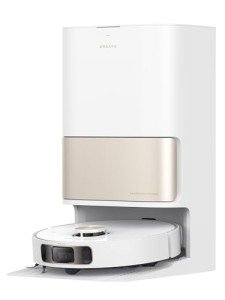10 Instagram Accounts On Pinterest To Follow Robotic Vacuums
The Rise of Robotic Vacuums: A Comprehensive Overview
In today's fast-paced world, innovation is consistently progressing to make our lives simpler, and the home cleaning segment has witnessed among the most noteworthy developments: the robotic vacuum. This intelligent gadget not just saves energy and time but likewise makes sure a cleaner home environment with minimal manual effort. This post delves into the remarkable development of robotic vacuums, how they work, their benefits and downsides, market patterns, and future instructions.
The Evolution of Robotic Vacuums
Robotic vacuums have made excellent strides given that their beginning in the late 1990s. The very first commercially readily available robotic vacuum was introduced in 1996, followed by various designs, each developed with escalating elegance and features. Here is a short timeline of robotic vacuum development:
Year
Occasion
1996
Introduce of the very first robotic vacuum (Electrolux's Trilobite)
2002
iRobot Roomba is launched, making robotics mainstream
2010
Intro of advanced mapping and navigation functions
2017
Combination of AI and smart home compatibility
2022
Release of highly advanced models including self-emptying dustbins
How Robotic Vacuums Work
Robotic vacuums use a mix of sensors, algorithms, and synthetic intelligence to browse spaces efficiently. Here's how they run:
Navigation: Most robotic vacuums use a series of sensing units to detect barriers and browse around furnishings. Some high-end models integrate LIDAR (Light Detection and Ranging) innovation to develop in-depth maps of the environment.
Cleaning Mechanisms: They are geared up with rotating brushes and suction systems to gather particles from numerous surfaces. Depending upon the model, they can shift in between carpets and tough floors perfectly.
Smart Features: Many modern-day robotic vacuums are Wi-Fi allowed, permitting users to manage them remotely via a mobile phone app. Features frequently consist of scheduling, mapping out cleaning paths, and integration with other smart home gadgets.
Self-Maintenance: High-end systems may include self-emptying abilities, where the robot can dock itself to a base that collects dust and particles without human intervention.
Benefits of Robotic Vacuums
Robotic vacuums have actually garnered tremendous appeal, and for good reasons. Here are some of the most significant benefits:
- Time-Saving: Automating the cleaning process enables users to participate in other meaningful activities.
- Effective Cleaning: Regular cleaning can be easily attained by arranging the robot to clean everyday or weekly, keeping dirt and irritants at manageable levels.
- Compact Design: Their little size enables them to fit under furniture and in hard-to-reach places.
In spite of their benefits, robotic vacuums also feature restrictions:
- Limited suction power: While they work for keeping tidy floors, they might not match the deep cleaning of standard vacuums.
- Battery life: Most designs need to return to their dock after a specific period of usage.
- Preliminary costs: High-quality robotic vacuums can be pricey, though prices have been reducing with developments in technology.
Present Market Trends
The marketplace for robotic vacuums is expanding quickly. According to a current marketing research report, the international robotic vacuum market is anticipated to reach ₤ 7.2 billion by 2027, growing at a CAGR of 23.5%, driven by numerous factors:
Increased Adoption of Smart Home Devices
The rise of smart home innovation has actually motivated consumers to incorporate robotic vacuums into their families. Lots of robotic vacuums work effortlessly with home assistants like Amazon Alexa and Google Assistant, streamlining their operation.
Advances in Robotics and AI
As the technology behind robotic vacuums evolves, designs are being geared up with better navigation systems, AI algorithms for discovering individual cleaning habits, and boosted functions for specific floor types.
Focus on Health and Hygiene
The heightened awareness of tidiness and health, especially due to current global occasions, has driven customers to purchase gadgets that regularly get rid of dust, allergens, and pet hair from their homes.
Future Directions
As technology advances, robotic vacuums are expected to evolve further, incorporating functions that increase their efficiency in households. Anticipated advancements consist of:
- Improved AI Learning: With developments in device knowing, future models will be better at comprehending their environment and adjusting to the needs of their owners.
- Multi-Purpose Design: Potential future designs may consist of features for mopping, sanitizing, and air purification in addition to vacuuming.
- Sustainability: As eco-consciousness rises, makers are most likely to focus on energy effectiveness, recyclable products, and sustainable production practices.
FAQs About Robotic Vacuums
**1. Can robotic vacuums vacuum on carpet?Yes, most robotic vacuums can transition in between different floor types, including carpets and difficult floors. 2. How often must I run my robotic vacuum?It depends
on your family's cleaning requirements, however lots of users
schedule their robotic vacuums to run daily or every couple of days. 3. Are robotic vacuums worth the investment?For many consumers, the time saved and benefit offered by robotic vacuums makes them rewarding,
**
especially for busy homes. 4. Can self cleaning vacuum control my robotic vacuum remotely?Most modern robotic vacuums can be controlled via a smartphone app, enabling scheduling and monitoring from anywhere. 5. Do I still require a traditional vacuum cleaner?While robotic vacuums effectively handle everyday cleaning, a standard vacuum might still be essential for deep cleans or toughermesses. The improvement of robotic vacuums reflects a significant leap in automating household chores, combining innovative innovation with easy to use operation. As the trend toward smart homes continues and customer expectations evolve, robotic vacuums will likely keep enhancing, supplying ever-greater benefit and performance in maintaining tidy living spaces. As property owners consider the prospective advantages and limitations of these gadgets, it is clear that robotic vacuums have solidified their credibility as vital tools in modern home management. 